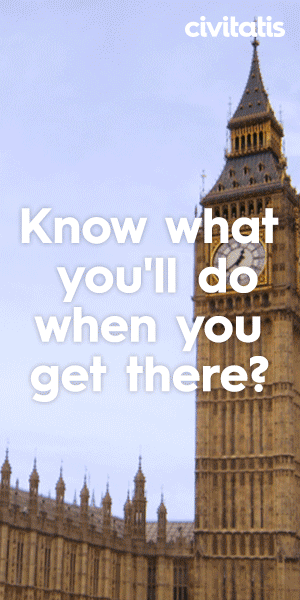While staying in Bonn Germany, I’d frequently take the train to Köln. Not only because Köln is the nightlife hub for the region but to visit Köln’s many museums, cultural artifacts, art galleries and man-made beaches.
Here’s a brief background on Köln. And a few of the attractions that I’d recommend for those considering a short stop in Köln Germany.
A Short Stopover Köln Germany
Köln Germany | Cologne Germany
As a region Köln has been continuously inhabited for over two millennia. But don’t expect to see a lot of traditional German buildings and people carrying large jugs of beer clad in lederhosen. That’s in Bavaria and not Köln.
Köln is a modern city spattered with museums, galleries and sites of historical interest. It’s home to one of the most visited sites in Germany. The Kölner Dom which is also called the Cologne Cathedral.
This grand gothic cathedral was once home to relics of the Biblical Magi (three kings). And it is still the tallest twin spire church in the world. It’s so tall in fact that it acts as a beacon and is used to guide visitors around the city.
Yet, the Kölner Dom also acted as a beacon in the Second World War and was used by allied aircraft to line up their bombing runs. So there isn’t many buildings in Köln that are older than 1945 or that weren’t extensively rebuilt after the war. Instead, history in Köln is often found in its many wonderful museums.
The museums in Köln are some of the best in Germany. The Roman-Germanic museum which preserves a 3rd century roman villa and Dionysian mosaic, along with many other artifacts from the regions roman settlements is one of the best in my view. And it’s located so close to many other museums!
All of the main museums, galleries and points of interest in Köln are quite close together. Sometimes right next to each other. And as an eminently walkable city it’s so easy for visitors to just stroll from one museum or gallery to the next.
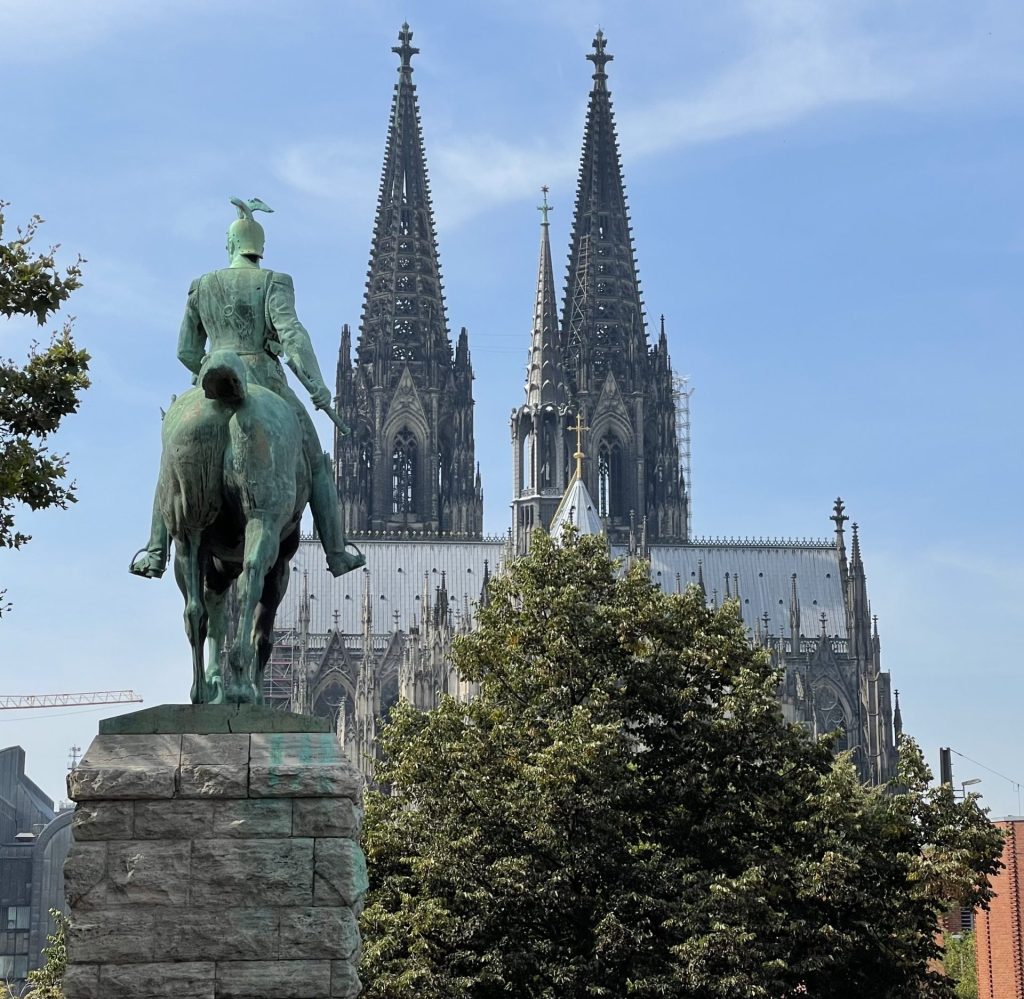
Getting to Köln Germany
Köln does have an International airport servicing its 3.6 million inhabitants. And the Rhine cruises do stop in Köln. Yet most visitors and tourists will arrive in Köln at the Hauptbahnhof (central train station) via the Deutsche Bahn.
The airport in Köln is small when compared to Frankfurt. And Frankfurt airport services a wider array of destinations and carriers. Flights are cheaper to Frankfurt and most people flying into this part of Germany will first arrive in Frankfurt. They will then take the train from Frankfurt to Köln.
I arrived into Frankfurt and made my way via train to Bonn. As I was staying in Bonn I frequently travelled to Köln to visit sites, for nightlife and shopping. The train between Bonn and Köln takes 20 to 30 minutes depending on its designation (express or stopping).
The trains between Bonn and Köln, like all trains in Germany, are very cheap if you book ahead or use a mobile application like OMIO. Don’t leave booking trains in Germany to the last minute as they get more expensive. Flights seem to get cheaper closer to departure and trains definitely get more expensive.
OMIO was the cheapest travel search engine in Europe and it has all of the Deutsche Bahn trains at prices cheaper than just buying a ticket at the station. It’s where I get all of my tickets when in Germany.
You can find OMIO at www.omio.com
Getting Around Köln Germany
As with most cities in Germany the public transport system is well developed and functional. Trains, trams and the subway are the most common method of transport. There are buses and taxis though they are used less frequently. And in the new COVID normal we all find ourselves in, busses are likely to remain the less popular transport option.
Uber has a small presence in Köln and the Uber application will work. Yet Uber will be expensive compared to the rail systems and will likely be slower to get you to your destination. With the exception of a couple of trips in the early hours of the morning, I never found a need to use Uber anywhere in Germany.
Is Köln Walkable?
The centre of Köln Germany is walkable. It’s a maze of pedestrian only alleys and streets lined with cafes and restaurants. There are boardwalks along either side of the Rhine.
I walked almost everywhere during my trips to Köln. If a destination was a little further than I wanted to walk on a given day or the weather looked like it may turn inclement, I’d simply hop on a tram to a stop near my destination and merely walk the last little bit.
I didn’t find myself needing to use taxis or ride sharing applications because all the places a tourist might want to go in Köln are relatively close to the centre and can be reached on foot. So most of the time I got a coffee and wandered to my destination.
Is Köln Safe?
Köln is very safe. Particularly around the touristic parts of the city centre. With the slight exception of the Hauptbahnhof where you might encounter pickpockets or petty thieves.
There’s something about train stations that seems to attract weird people. You’ll find the busy Hauptbahnhof which sits behind the Köln Cathedral has one of the highest densities of homeless people and people with substance abuse problems.
The Hauptbahnhof and its surrounding area is not dangerous. And violent crime is not common in Köln. But you should keep an eye on your bags and a hand on your wallet. Particularly in the vicinity of the Hauptbahnhof, to avoid any opportunistic thief walking off with either.
Weather in Köln
Despite being in Germany during one of its wetter summers on record, I had good weather most of the time. One weekend trip from Bonn to Köln was a little wet. But during my longer stay in Köln before heading to Berlin for a week, the weather was superb.
The daytime weather was warm and sunny. And even a little muggy at times. It was summer and the temperatures ranged from 28°C during the day to as low as 18°C at night. For me the weather felt neither hot nor cold at any point and with long sunny days it was rather pleasant.
Winter is a different story. It gets cold in Germany during the winter. And Köln is no exception. Winter will range in temperature from about 9°C to -9°C. And the days will be much shorter in winter.
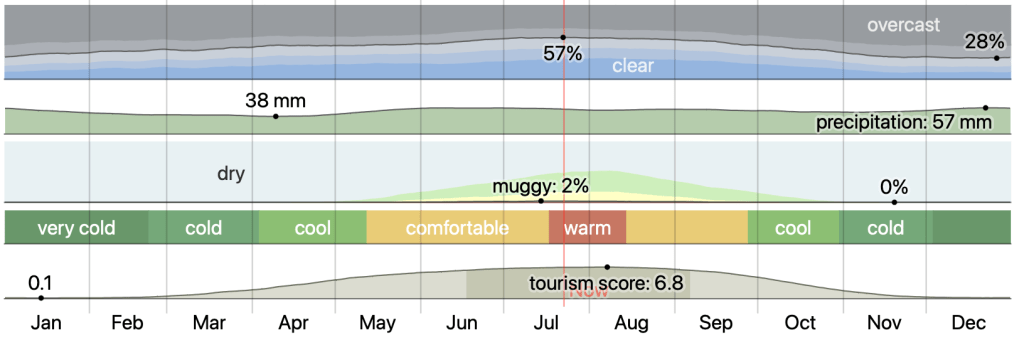
Where to Stay in Köln Germany?
I stayed in the Hotel Motel One Köln-Neumarkt. As I had used the ‘Motel One’ chain in a few German cities including a long stay in Motel One while living in Bonn. And I had always found them to be one of the best options in Germany. Köln was no exception.
Hotel Motel One Köln-Neumarkt was a short walk from all the tourist sights in Köln that I cover below. And the rooms were clean, modern and well designed. It also didn’t hurt that Motel One doesn’t cost a fortune.
On my way back to Bonn from Copenhagen I once again stopped in Köln. Yet this time the three Motel One locations in Köln were booked out. So, I stayed in the Kommerzhotel Köln.
Kommerzhotel Köln is not as new and swanky as the Motel One. But I managed to get it for almost half the price. And as the location is right across the road from the Hauptbahnhof and only a 3 minute stroll to the Köln Cathedral, it made the Kommerzhotel a really good place to stay.
The location of the Kommerzhotel Köln is so good I might even stay here again on my next trip to Köln. And maybe save some money I would otherwise spend on the Motel One.
Short Stay in Köln – Airbnb or Hotel?
I chose Hotels on my trips to Köln. Mainly because they were so cheap compared to the available Airbnbs. There are Airbnb’s in Köln and some of them are quite nice. Yet the hotels offered more amenities and were more competitively priced during my stops in Köln.
Köln Tourist Attractions to visit on a short trip to Köln
The tourists attractions I’ve covered below are by no means the full list of what’s available to see and do in Köln. They’re only some of the big ticket items that I believe you should endeavor to visit.
If you manage to see everything listed below on your trip to Köln you’ll have a good idea of what life is like in Köln both now and in the past. Köln is a big place. It’s roughly 10 times the size of nearby Bonn. And it has roughly 10 times the number of historical sites and museums that Bonn has.
So don’t expect to be able to see everything in a single trip. Instead see the big ticket items listed below and relax for a beer by Blackfoot Beach or at one of Köln’s many famed Kölsch Brauhaus (brewpub).
The Kölsch Brauhaus are where the waiters will keep bringing new rounds of Kölsch to your table until you put your coaster over the top of your glass to signal you’re finished. Or you fall off your seat in a drunken heap. My favorite Kölsch Brauhaus is Brauhaus FRÜH am Dom. Check it out!
All the attractions below can be visited inside 48 hours. And almost all attractions can be reached on foot from accommodations in central Köln. The only exception is Blackfoot Beach that is best reached via car with taxis and Uber available for those without access to a vehicle.
- Cologne Cathedral
- Museum Ludwig
- Hohenzollern Bridge
- Roman-Germanic Museum Cologne
- EL-DE Haus
- Blackfoot Beach
- Old Town
Kölner Dom | Cologne Cathedral
The Kölner Dom which is also known as the Cologne Cathedral is likely the most well known tourist attraction in Köln. This gothic cathedral is Germany’s most visited landmark. It draws tourists from all over Germany and the rest of the world.
The current cathedral on the site was built in stages between 1248 and 1880 AD. The plans to build the cathedral were drawn up and the foundation stone laid in 1248, but the construction was only completed in fits and starts. Because it was an ambitious project.
The cathedral was begun on account of the Archbishop of Köln coming into possession of the relics of the Biblical Magi (three kings). But its construction faltered due to the enormous costs and sheer magnitude of the project. To this day the church is the tallest in the world with two spires and has the largest facade of any church in the world.
It’s now not only a functional church and tourist attraction, but also a UNESCO world heritage site. The Kölner Dom was added to the UNESCO World Heritage List in 1996.

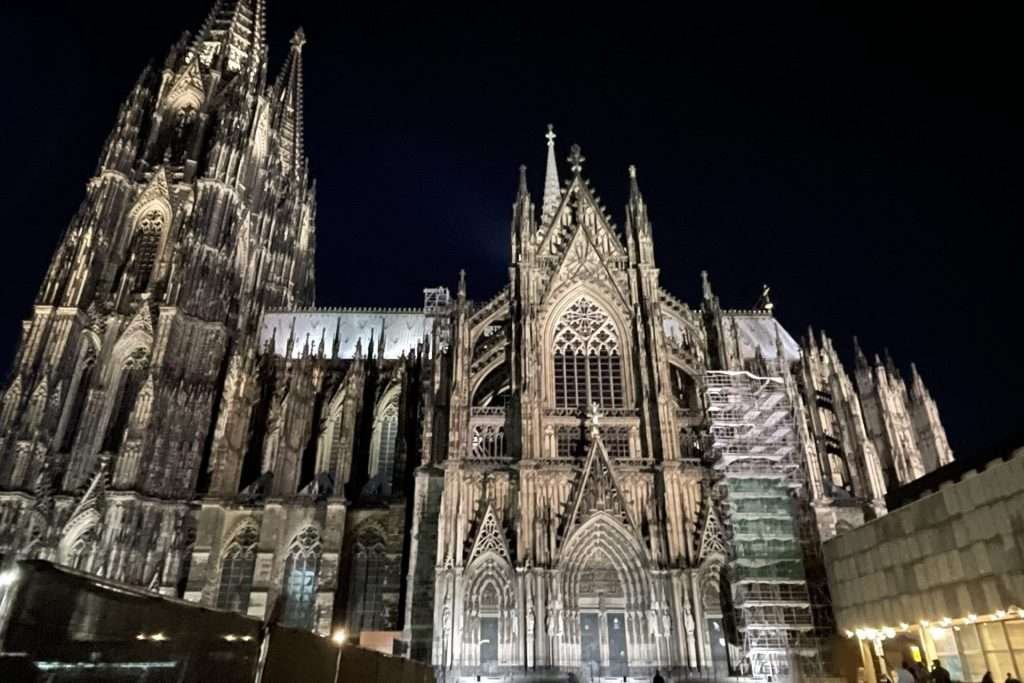
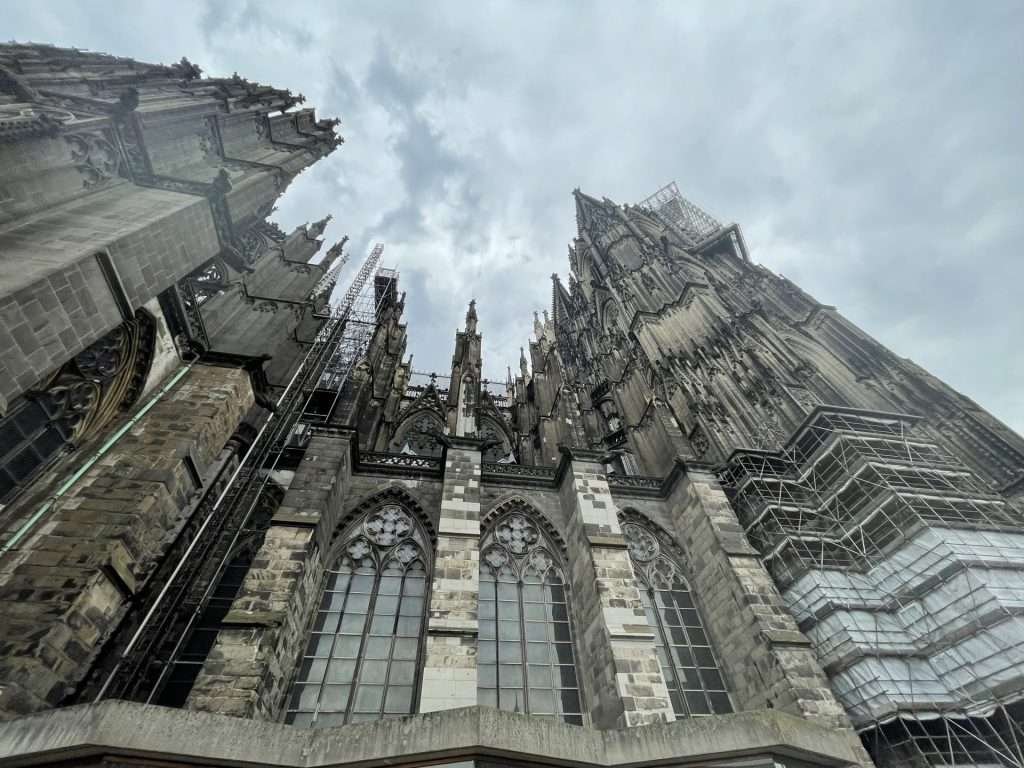
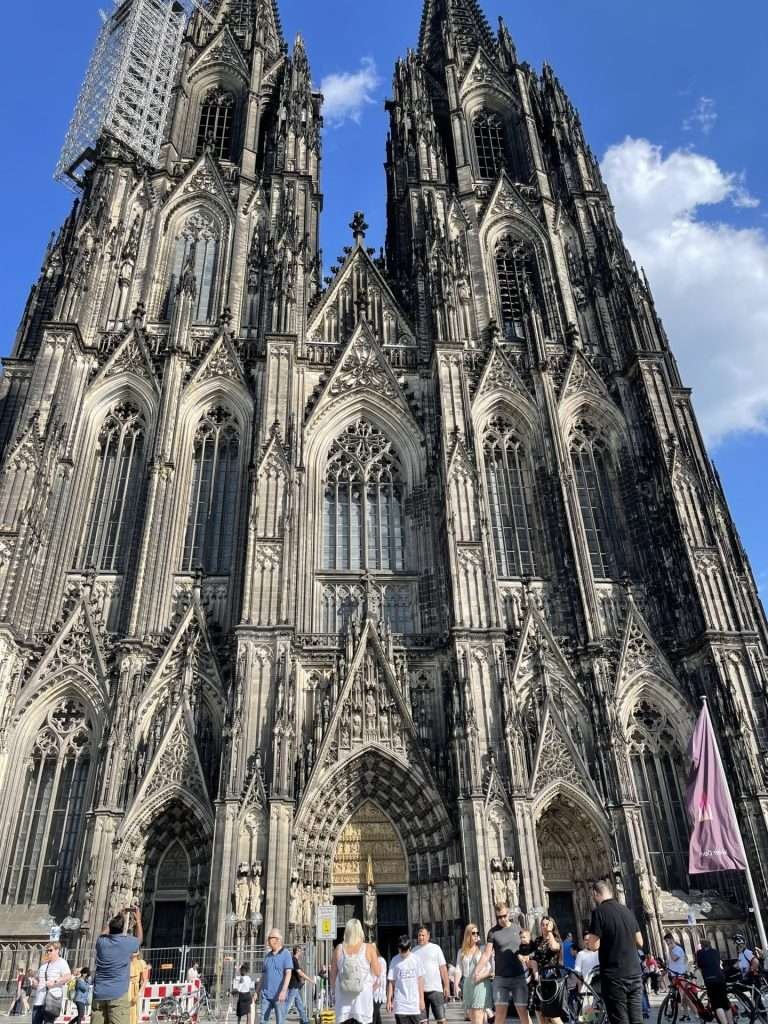
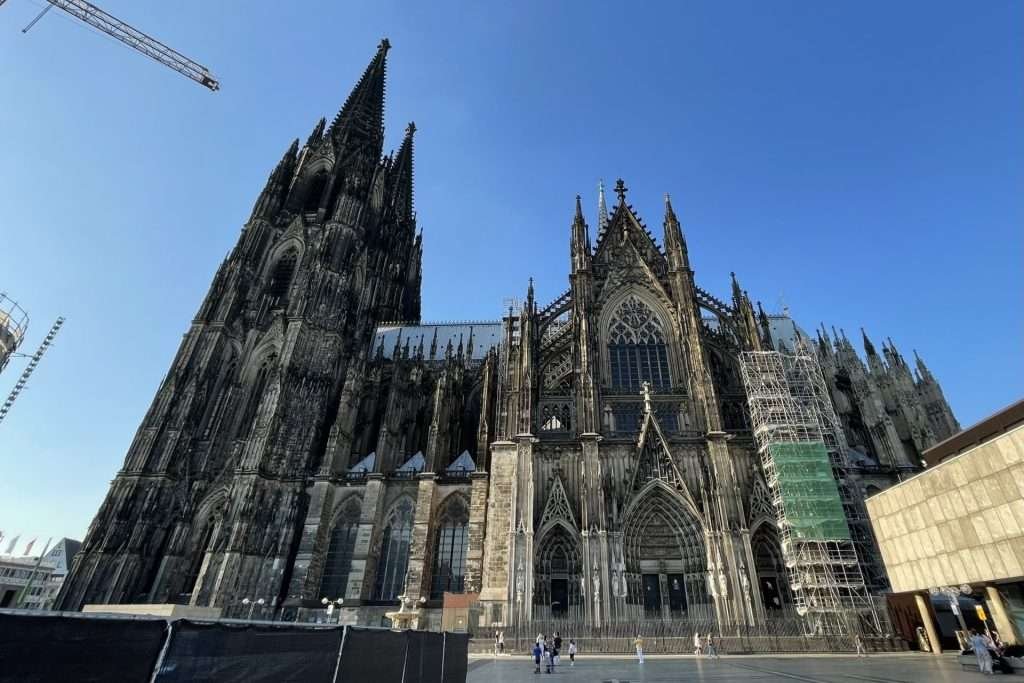
The interior of the Kölner Dom is massive. And with the exception of a stained-glass window that was destroyed, the interior sustained relatively little damage during the Second World War. In 2007 the stained-glass window that was destroyed during the Second World War was replaced.
Seen in the images below, the pixelated stained-glass window was the creation of German artist Gerhard Richter. And its installation caused some controversy. It’s a computer generated pixelated image instead of a religious depiction as shown in the pictures I’ve included of the other stained-glass windows in the cathedral.
When I toured the site the pixelated stained-glass window shown below did confuse me a little.
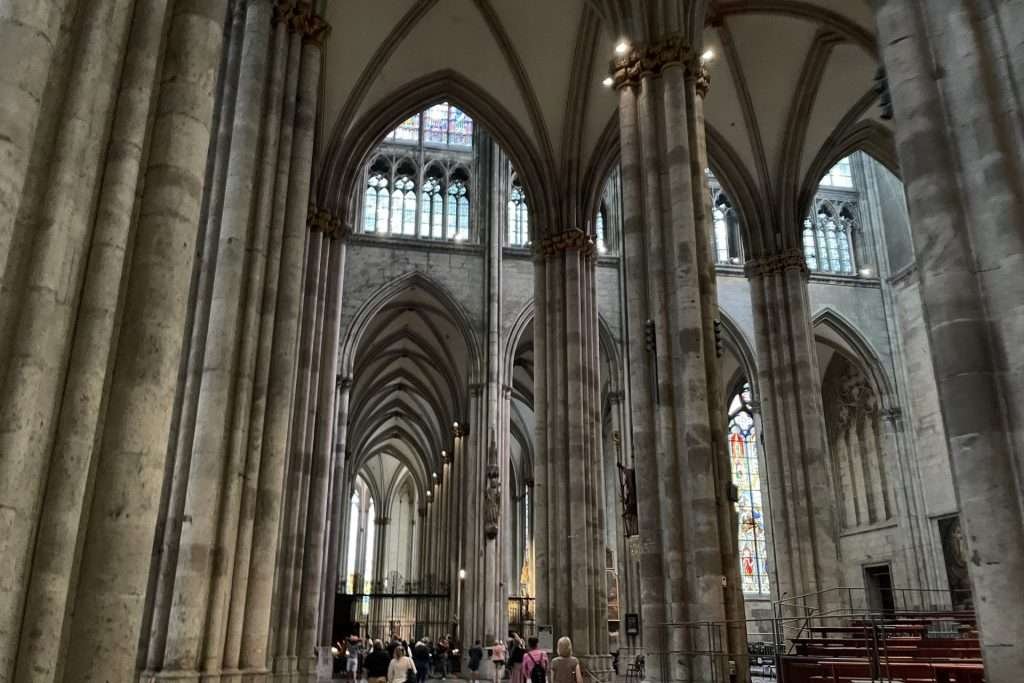
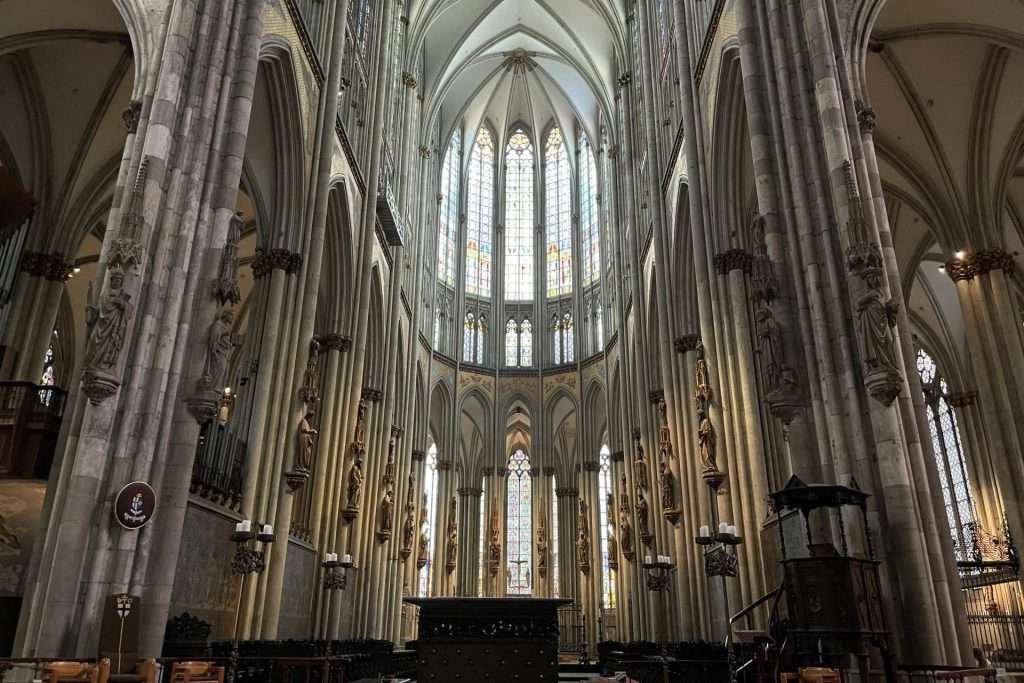
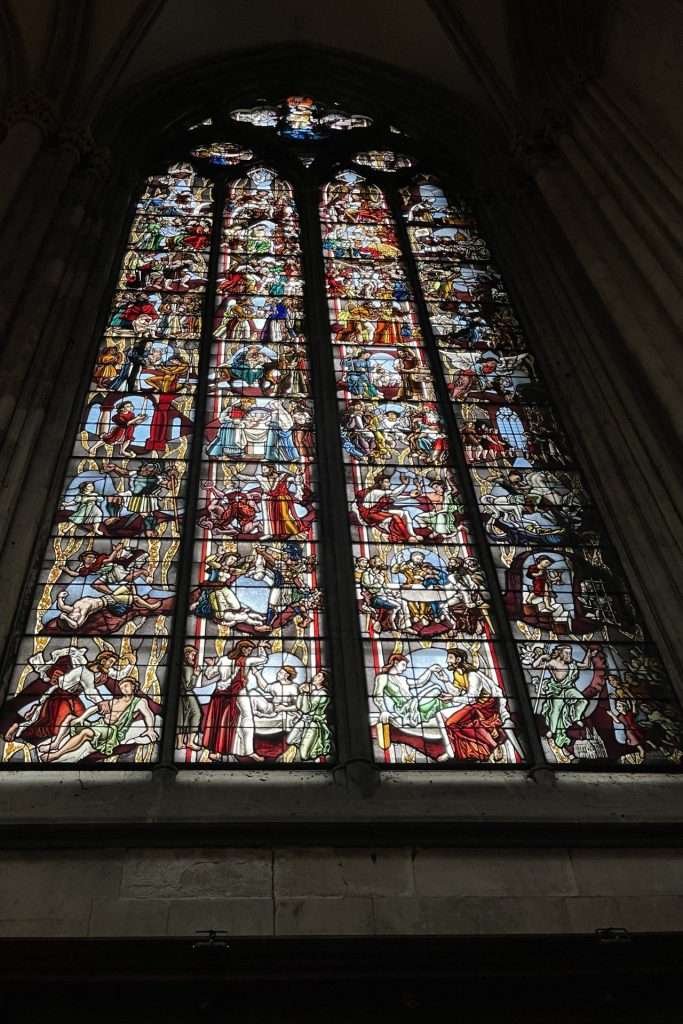
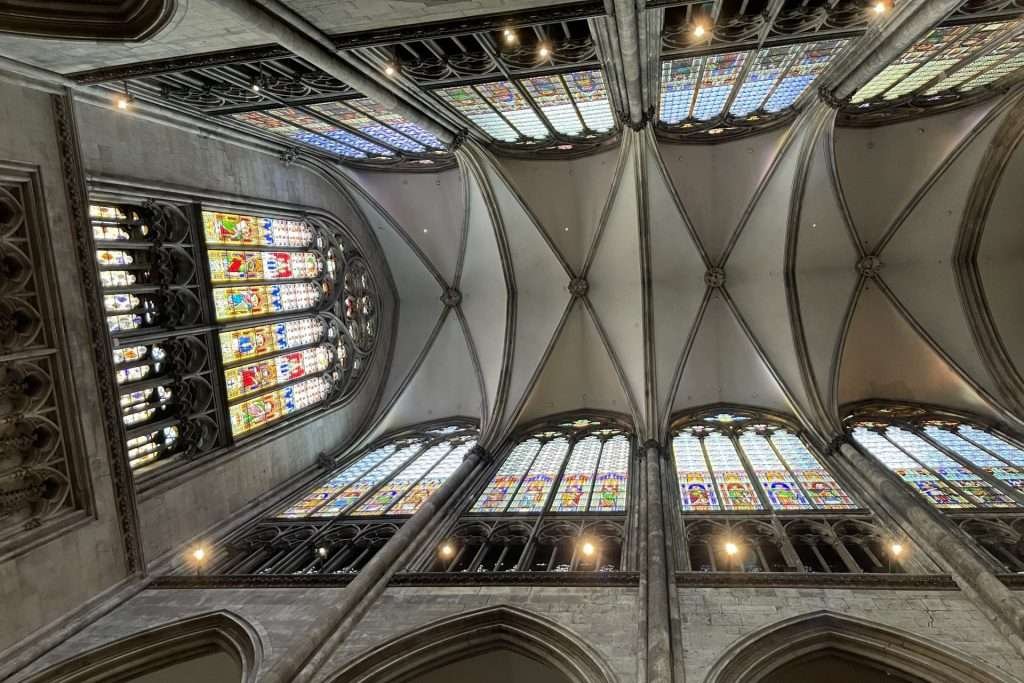
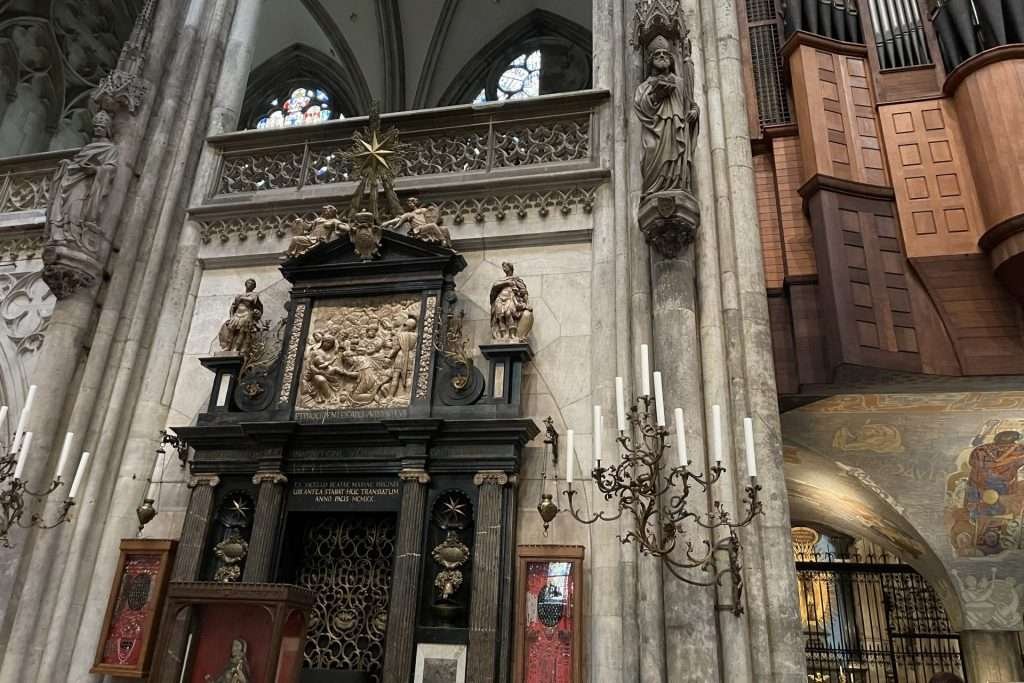
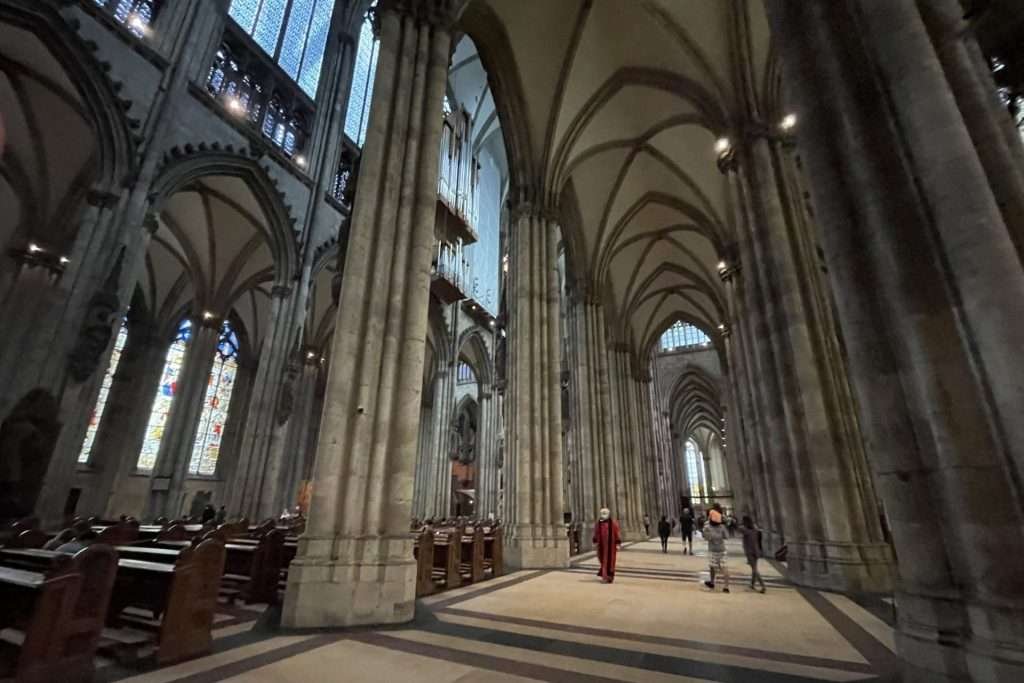
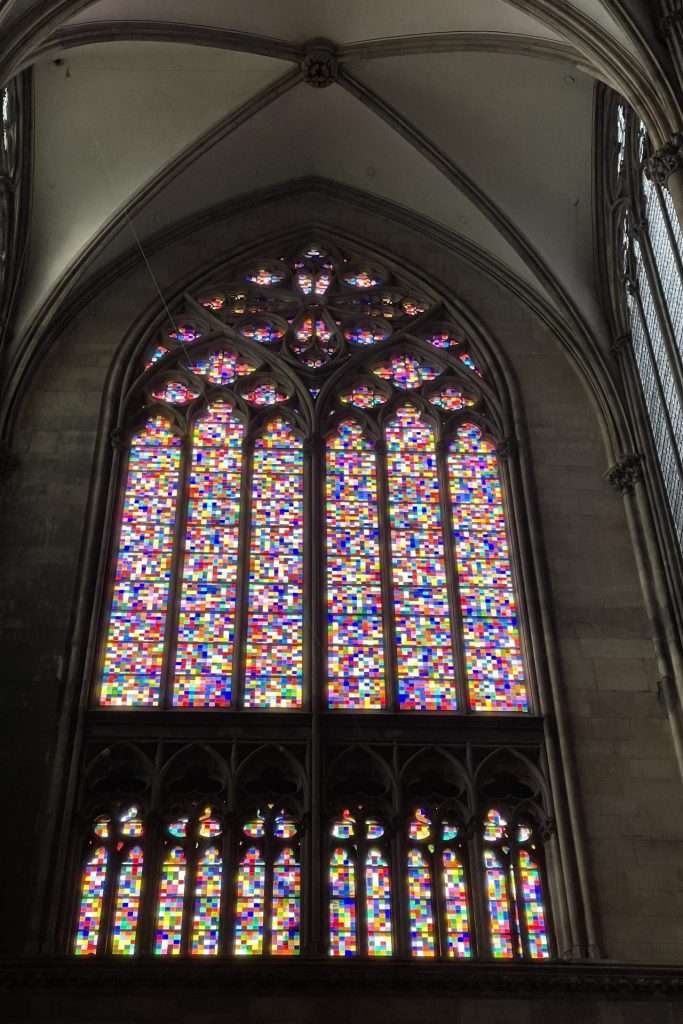
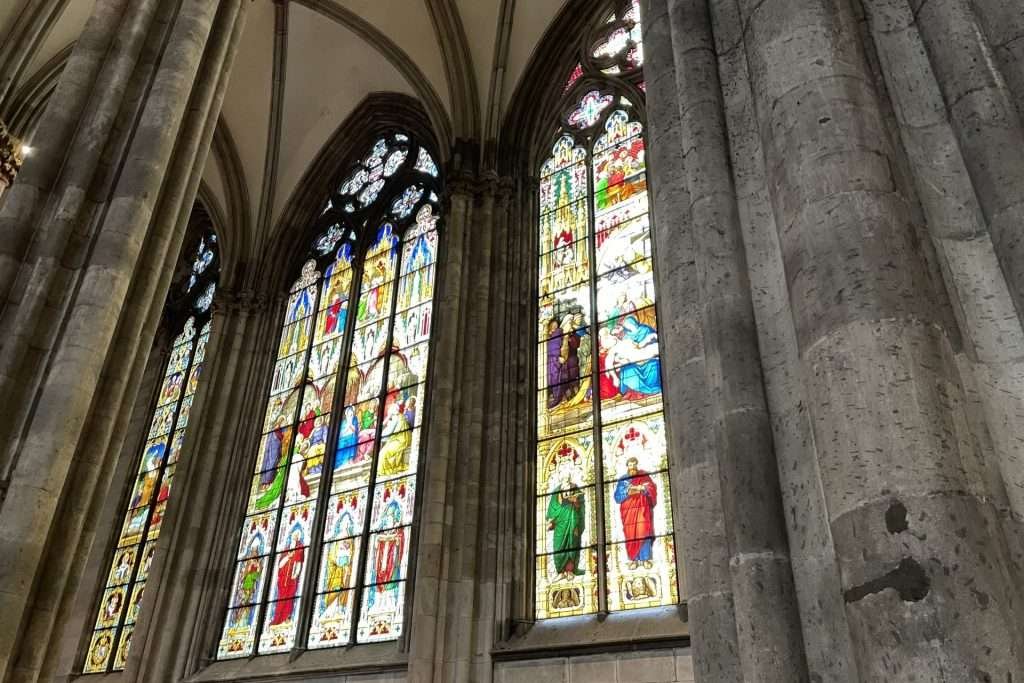
Museum Ludwig
The Museum Ludwig is next-door to the Kölner Dom. The museum houses the former private collection of Peter Ludwig. With over 900 works by Picasso the museum boasts the worlds third largest collection by Pablo Picasso.
‘If there were only one truth, you couldn’t paint a hundred canvases on the same theme.’
Pablo Picasso – Museum Ludwig
Among the collection donated by Ludwig, then valued at $45 Million, are works by pop artists Andy Warhol and Roy Lichtenstein. The museum also houses the largest and most comprehensive collection of early Russian avant-garde artworks outside of Russia.
I was fortunate enough to visit Museum Ludwig when the exhibition ‘In Situ: Photo Stories on Migration‘ was showing. And I would highly recommend the exhibit to anyone interested in the history of migration to Germany post 1945. If it’s ever showing again, do try and catch the exhibit.
The Kölner Philharmonie plays in the lower levels under the Heinrich-Böll-Platz. Which is the park you will need to walk through to get to the Hohenzollern Bridge beside the Museum Ludwig.
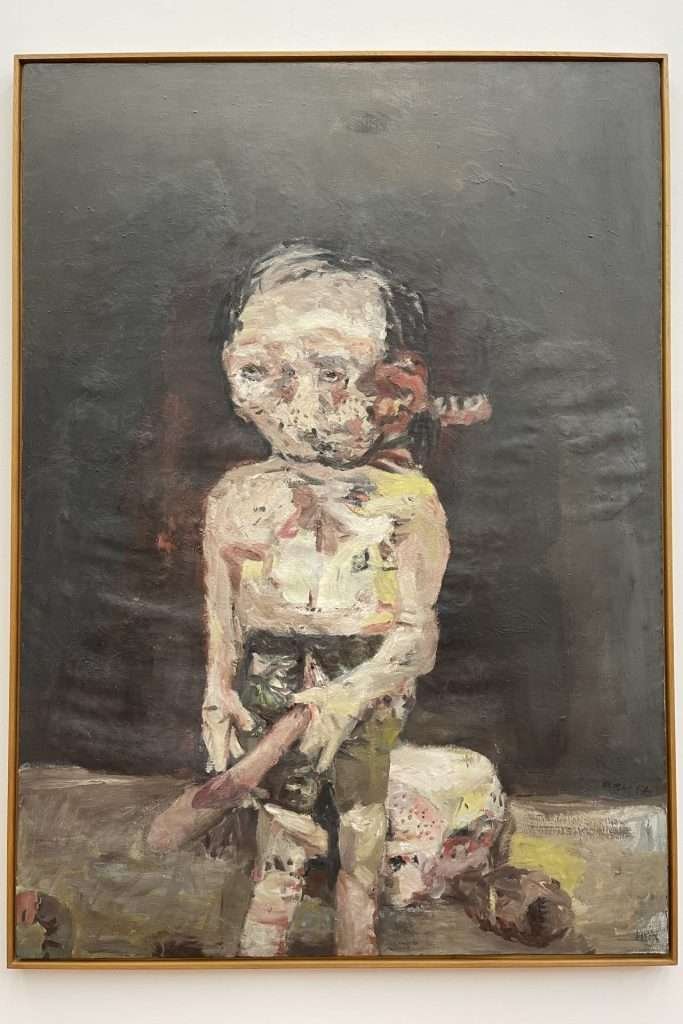
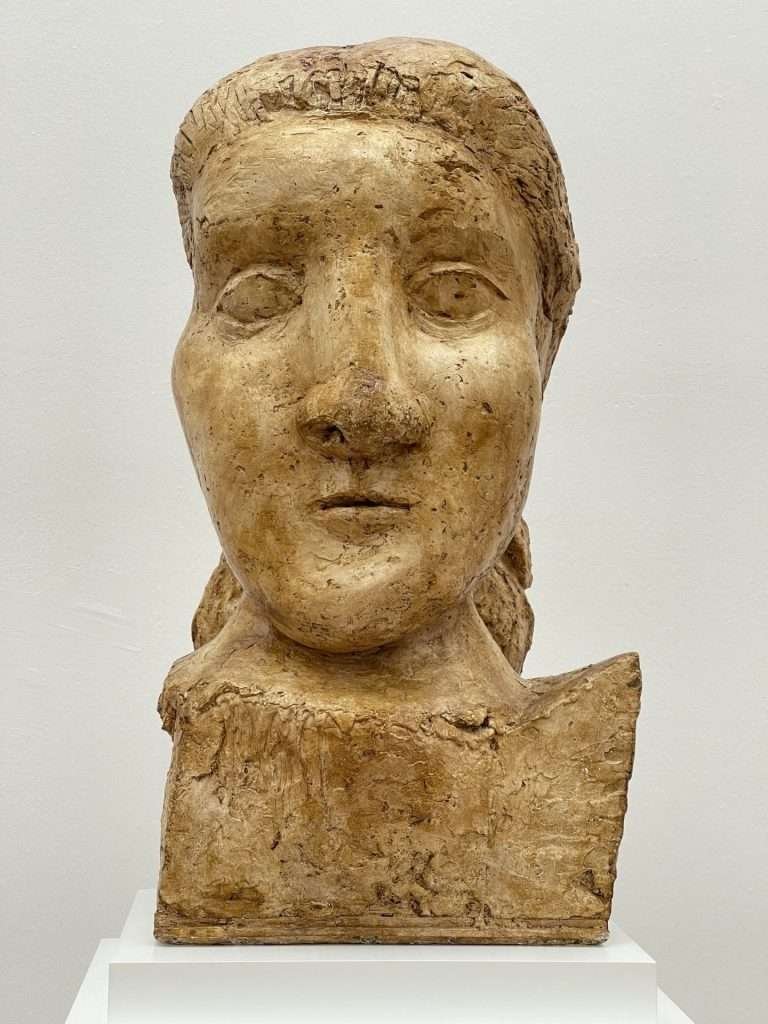
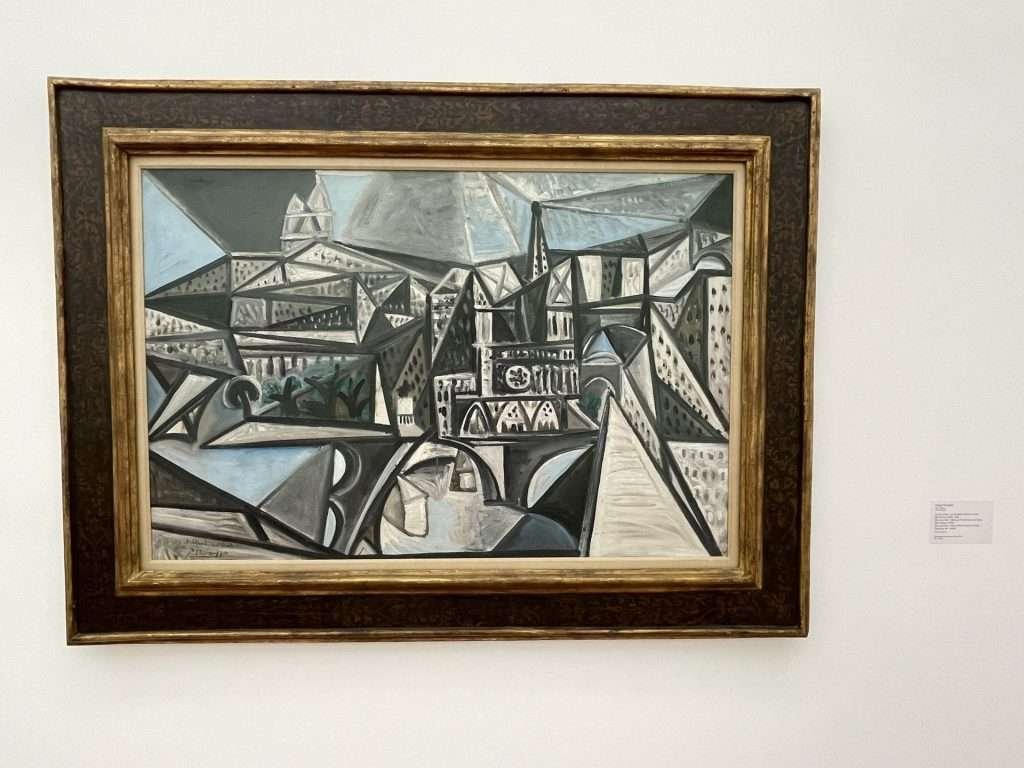
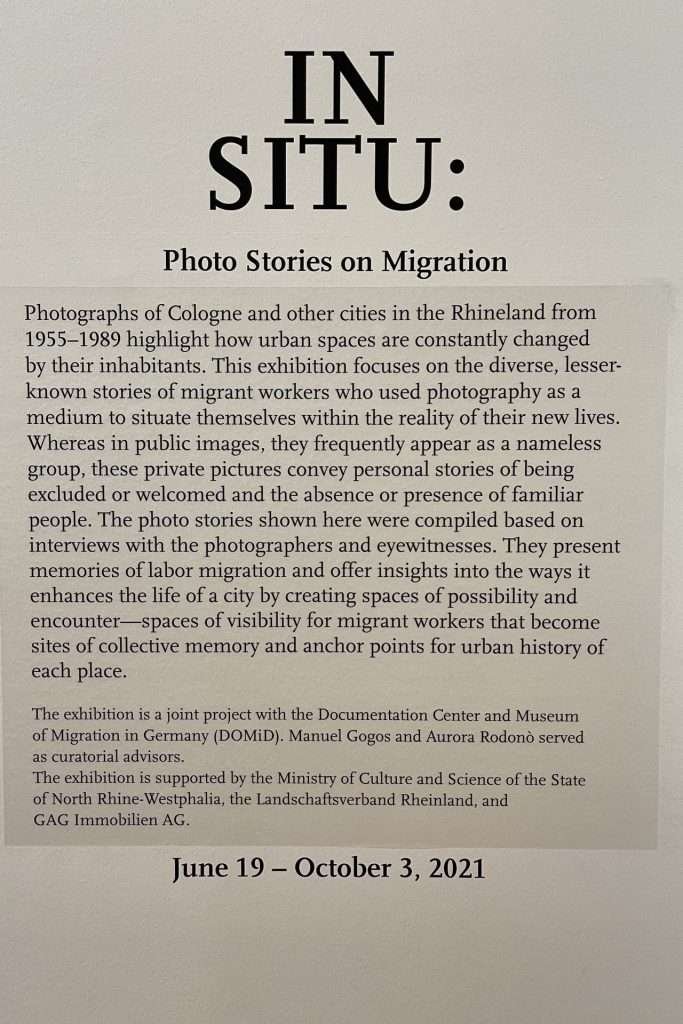
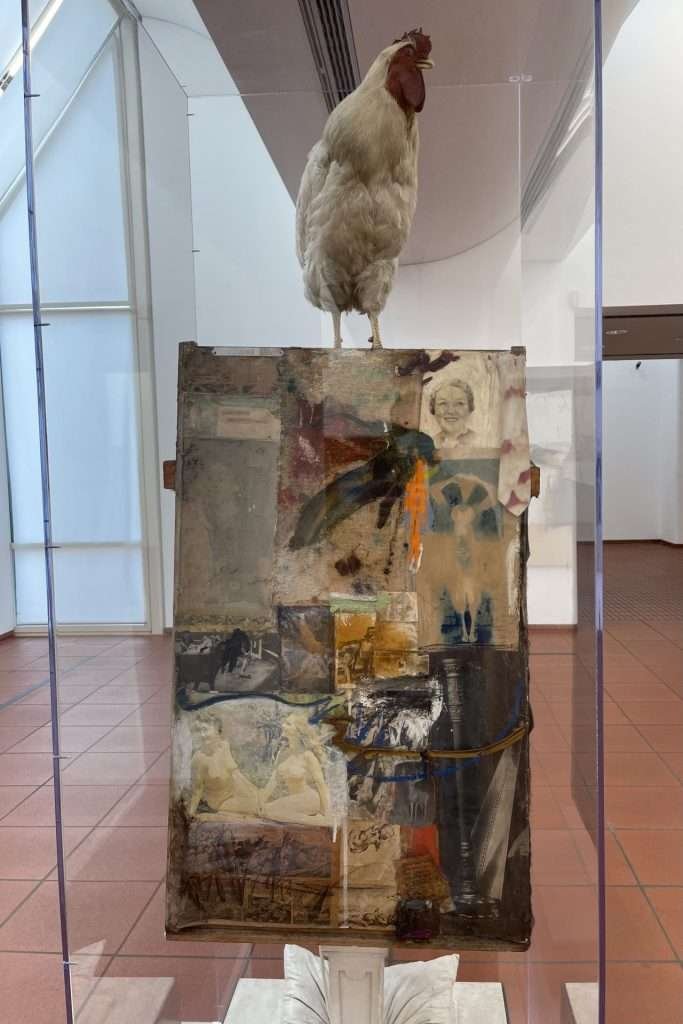
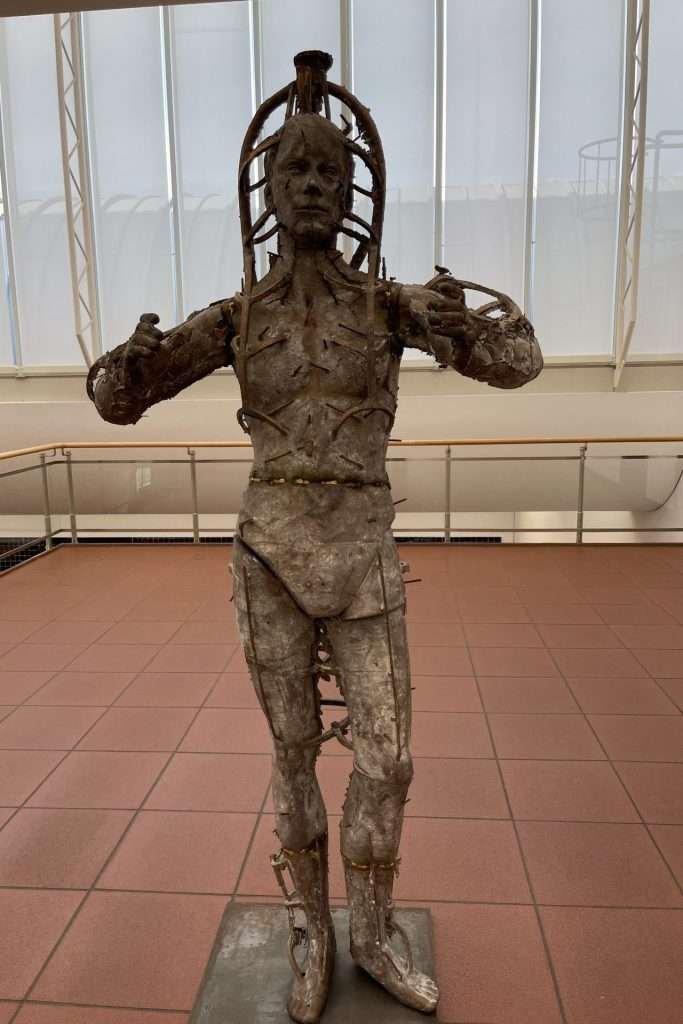

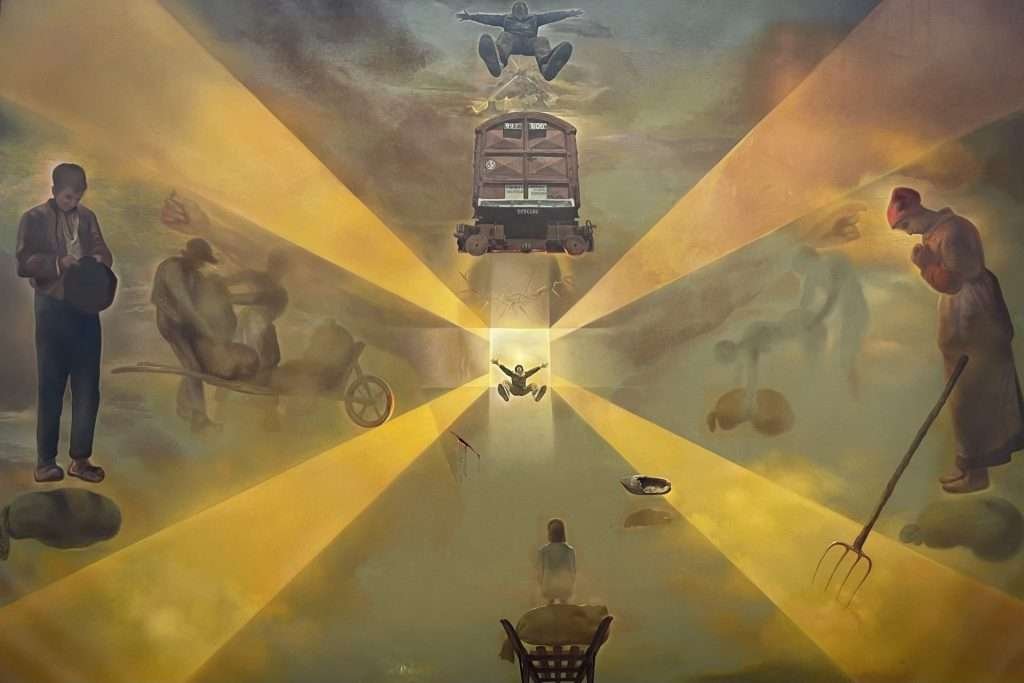

Hohenzollern Bridge Cologne Germany
Hohenzollern Bridge is Cologne’s ‘Love Lock’ Bridge. And at all hours of the day and night you can watch couples walking along the bridge to attach a lock and throw the key into the Rhine.
Given the rate of breakups these days, sitting by the bridge with a coffee I was half expecting to see some angry bird with a set of lock cutters removing one. But alas, it didn’t happen.
The Hohenzollern Bridge is just next door to the Museum Ludwig. And you will need to walk through the Heinrich-Böll-Platz park directly above the Kölner Philharmonie. When the Philharmonie are practicing or performing security guards will be everywhere, ensuring you don’t cross the park and are quiet in the area.
From the staircase at the end of the Heinrich-Böll-Platz park next to the bridge you have a great vantage point past the bridge and out over the Rhine. It’s a great spot to stop with a coffee and just take in the view in the morning.
Otherwise you can cross the bridge and there is a set of step like seats on the opposite bank of the Rhine. Where you can sit and look back at the bridge and cathedral as they light up in the evening.
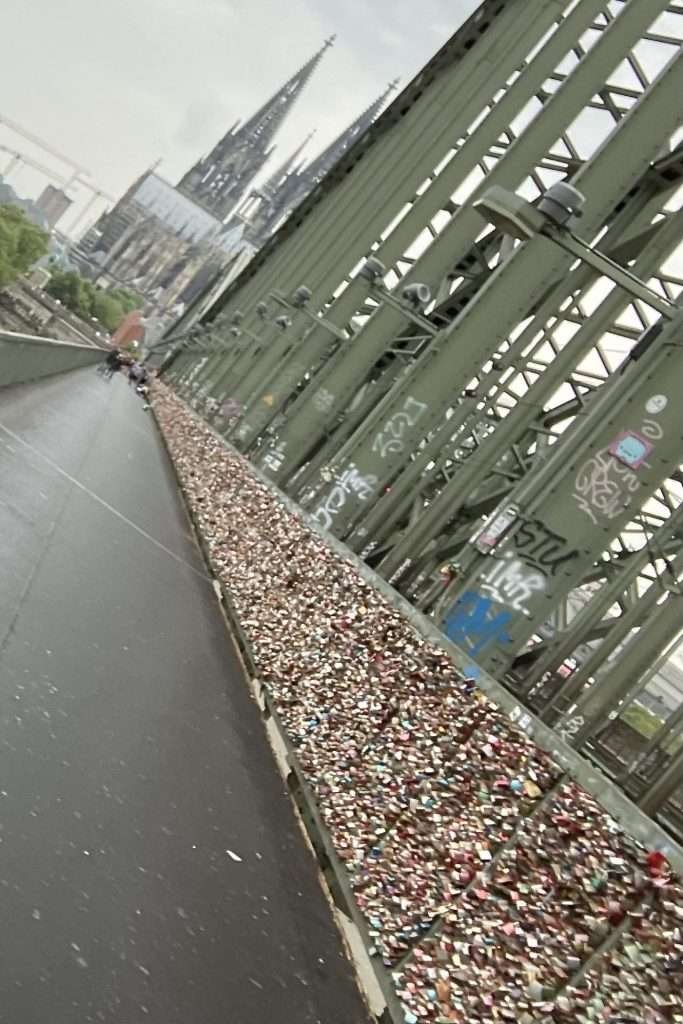
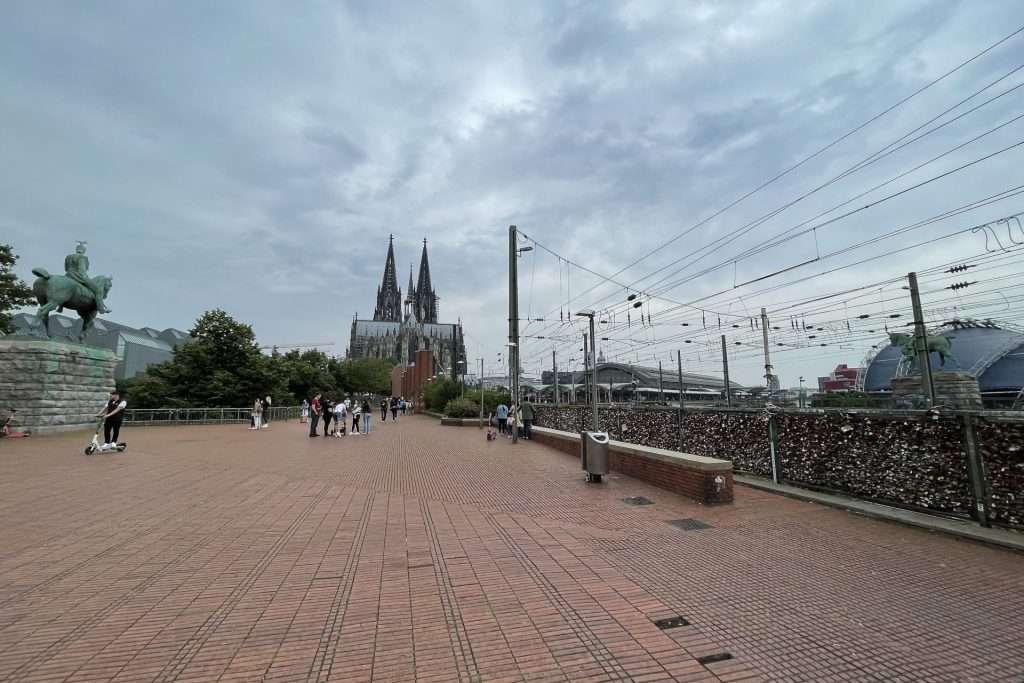
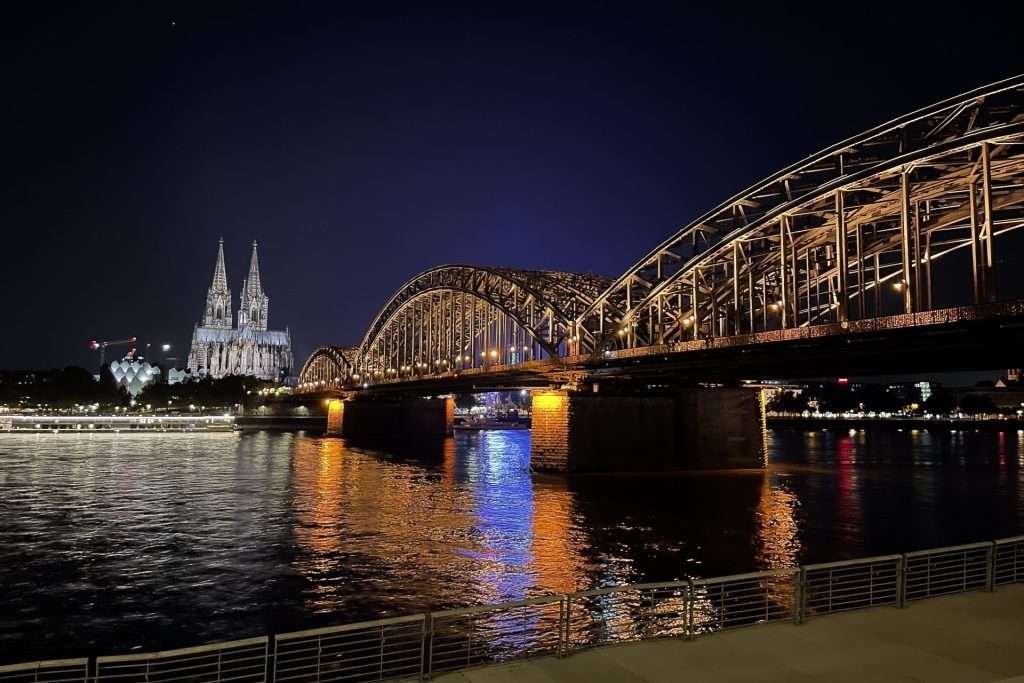
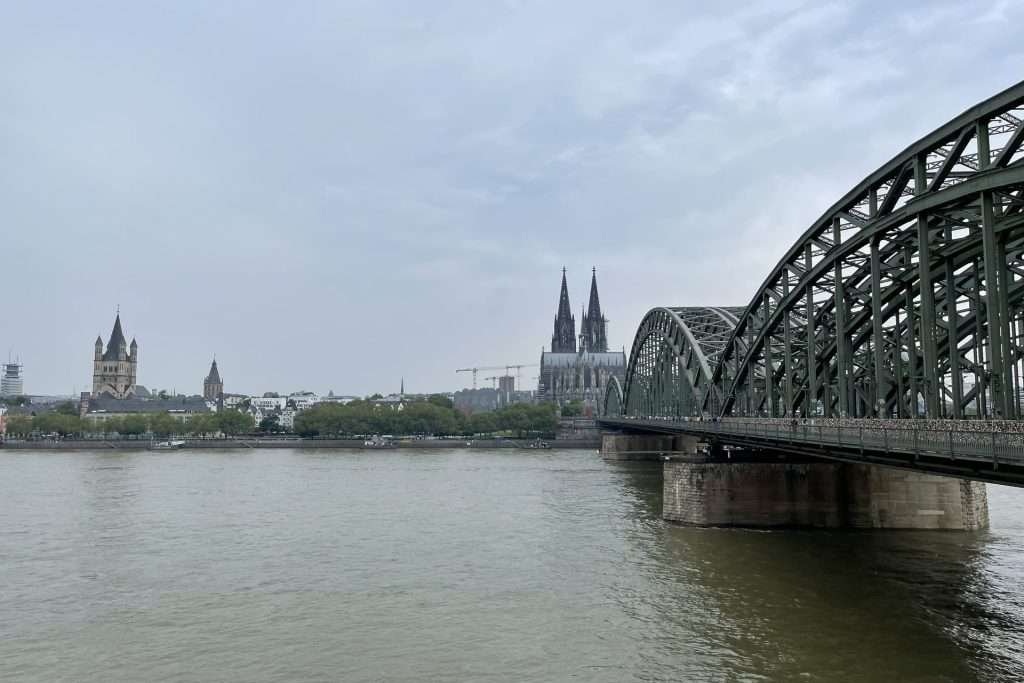
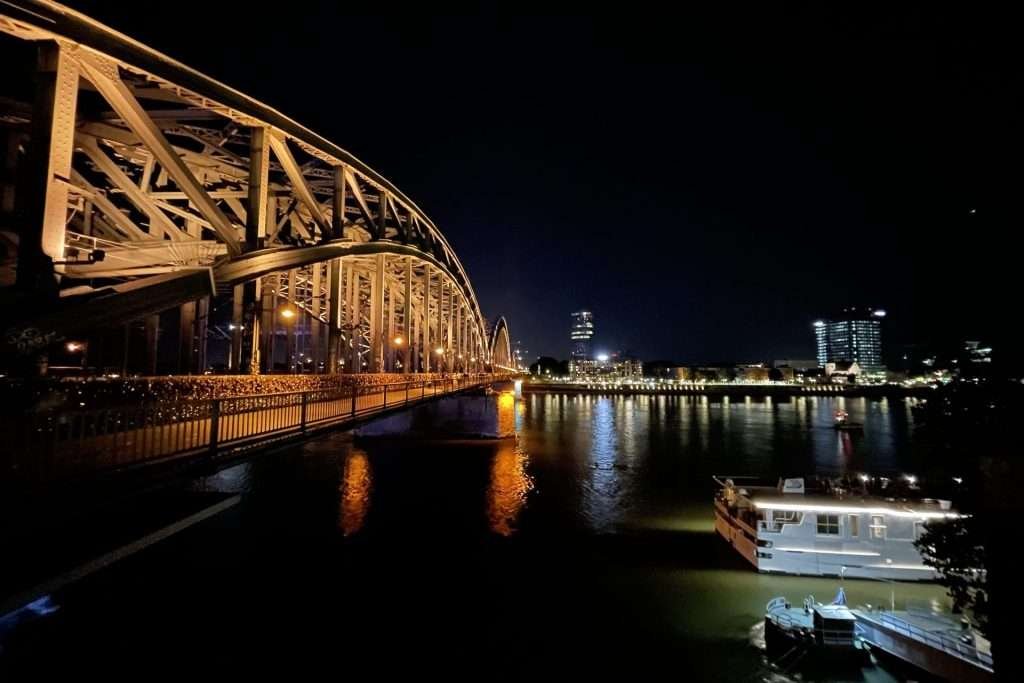
Cologne Triangle
The Cologne Triangle is the modern high-rise building on the other side of the Rhine opposite the Kölner Dom. It’s 103 meters tall and you can take an elevator to the top to view Köln from above.
To access the viewing platform at the top you will need to buy a ticket. It isn’t free but it is cheap. It’s worth the few € that it costs. And we quite enjoyed the view from the top. Even in the rain.
As you walk around the top of the Cologne Triangle you’ll notice that each landmark is marked on the glass. And it becomes a bit of a game to line up the landmark and try to spot it from above.
Allow about 30 minutes to 1 hour to see the Cologne Triangle. It doesn’t take long to see. But it’s certainly worthwhile for the view.
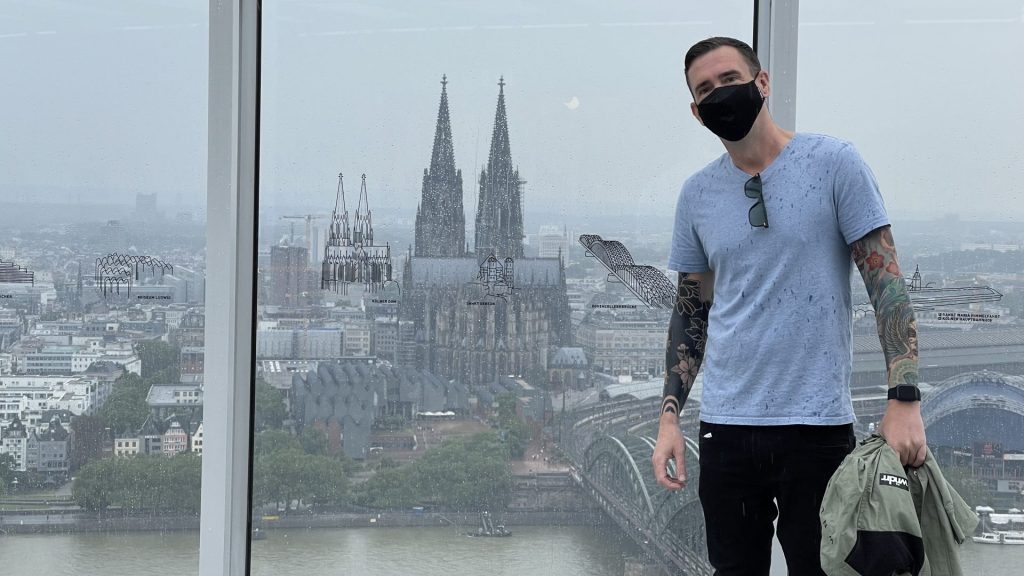
Römisch-Germanisches Museum | Roman-Germanic Museum
I lost half a day exploring the Roman-Germanic Museum in Köln. Normally the museum is housed next to the Museum Ludwig. But the building is undergoing a remodeling and the museum has been temporarily moved to a site a few blocks away. As such I couldn’t see the full collection. Nevertheless, what I was able to view took up the best part of half a day.
The Roman-Germanic Museum was one of the better museums I’ve seen in the region. The museum attempts to catalogue the history of Roman settlement in the Cologne area (including Bonn).
The original site of the museum (not the temporary exhibit) is an archaeological site and sits over a 3rd century Roman Villa and Roman road. And the museum has responsibility for protecting and preserving the Roman cultural heritage of Cologne.
Roman settlement in the area dates to at least 38 BC. And a large variety of weapons, tools, glass and jewelry have been located in the area. Some came from burial mounds as Cologne and Bonn have a number of important roman burial sites.
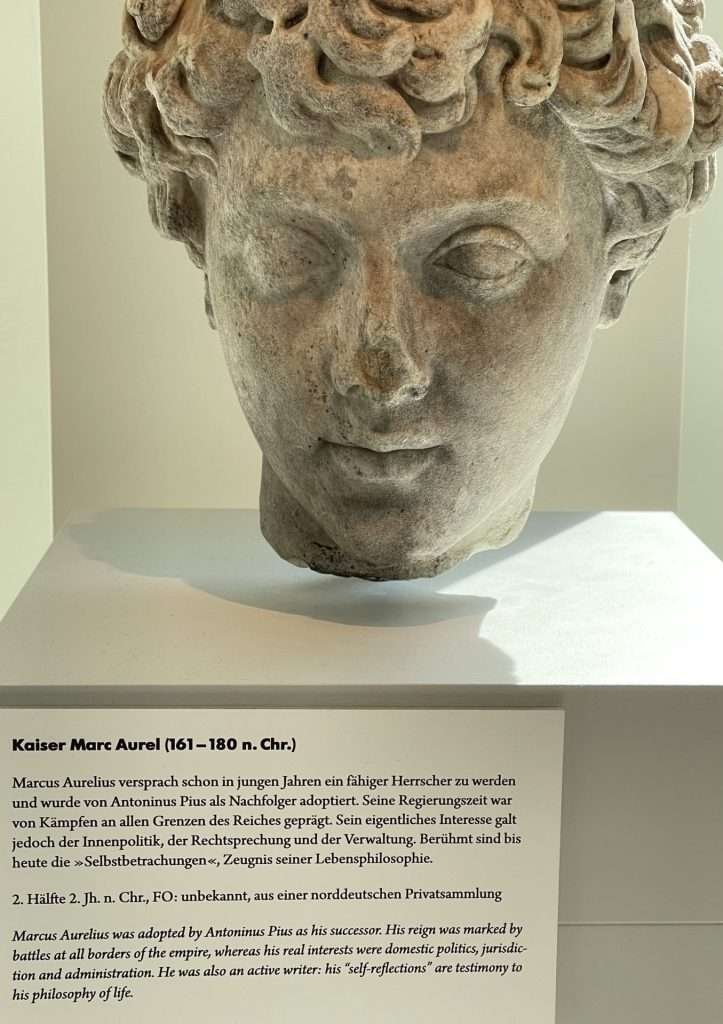
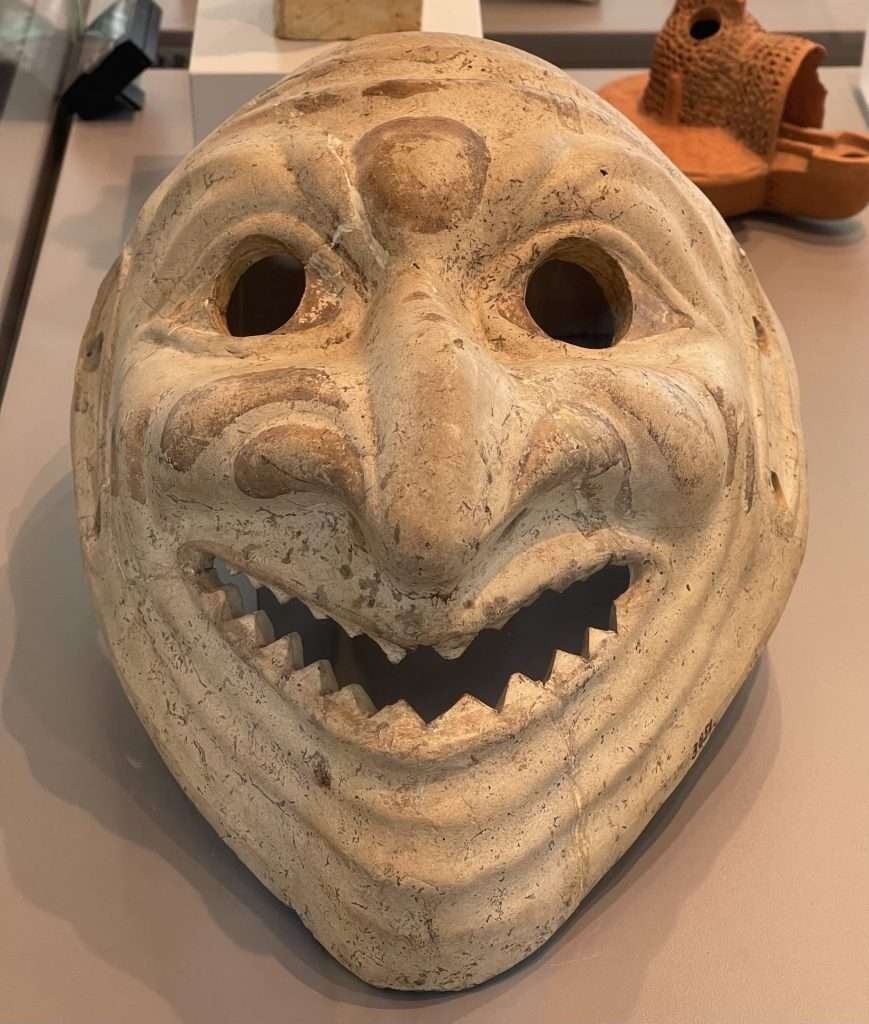
EL-DE Haus | NS Documentation Center of the City of Cologne (Köln) Germany
This innocuous looking building, now known as the EL-DE Haus, was once the site of the Gestapo headquarters for the region. And Köln along with the rest of North Rhine-Westphalia (NRW) was an important part of the Nazi rise to power.
In the overcrowded basement cells of EL-DE Haus, prisoners were disappeared, held, tortured and lead to their deaths in the central courtyard.
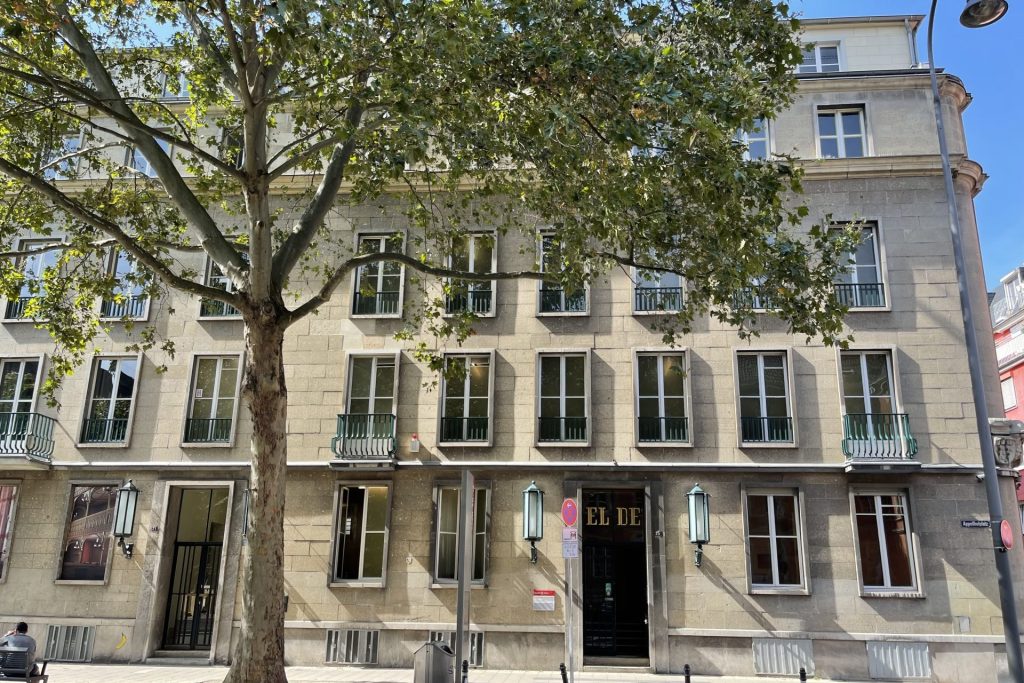
From late 1944 to the end of the war in 1945 the prisoners held in EL-DE Haus were lead out into the courtyard and brutally executed. Artists, poets, painters, academics and dissidents met their end in this abysmal little building.

Today the EL-DE Haus is a museum. It’s subject matter the rise to power of the Nazi Party and the role North Rhine-Westphalia (NRW) played in their coming to power.
The EL-DE Haus museum also chronicles the work of the Gestapo in the region. And has maintained the cells used by the Gestapo along with their extant files from the region. The museum and the basement cells in particular, are a horrible place to visit. But that’s the point.
The EL-DE Haus museum pulls no punches. It gives its visitors an unvarnished glimpse into the horrors perpetrated under the Nazi regime.
Today it’s a site of learning for school children and other visitors. It shows its visitors what they need to look out for from governments and from populist political parties that use hate to divide and conquer. The EL-DE Haus is definitely worth visiting while in Köln.
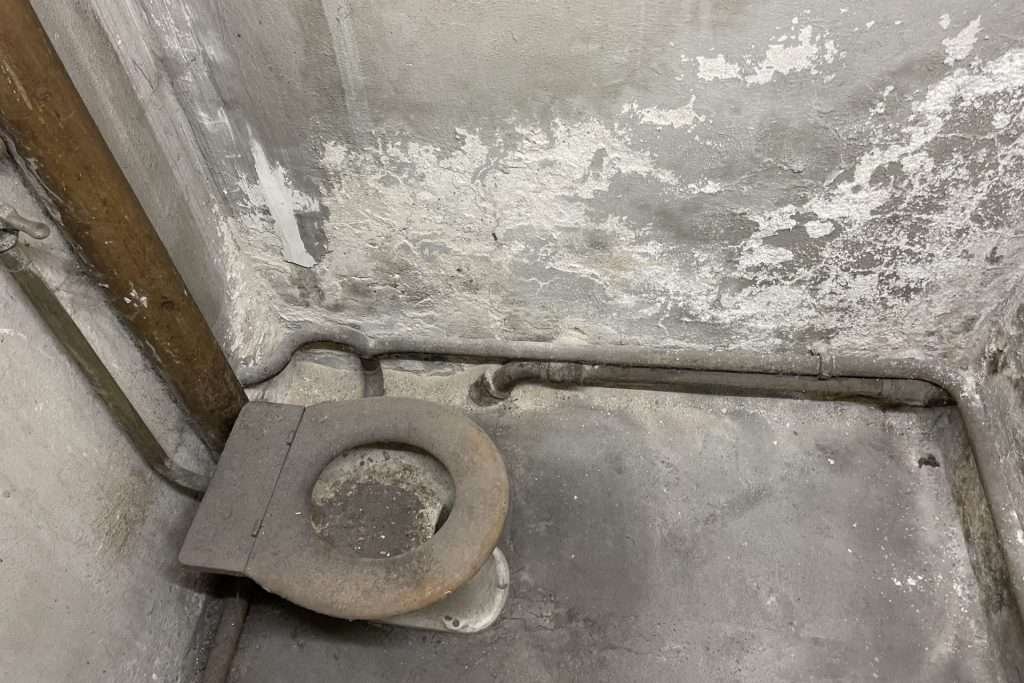
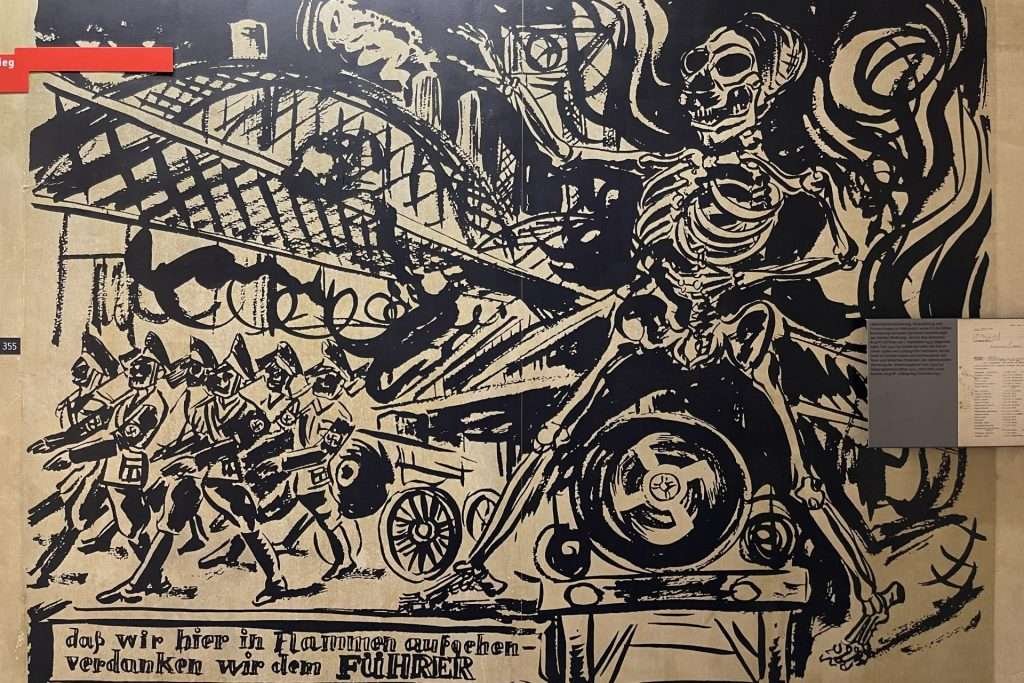
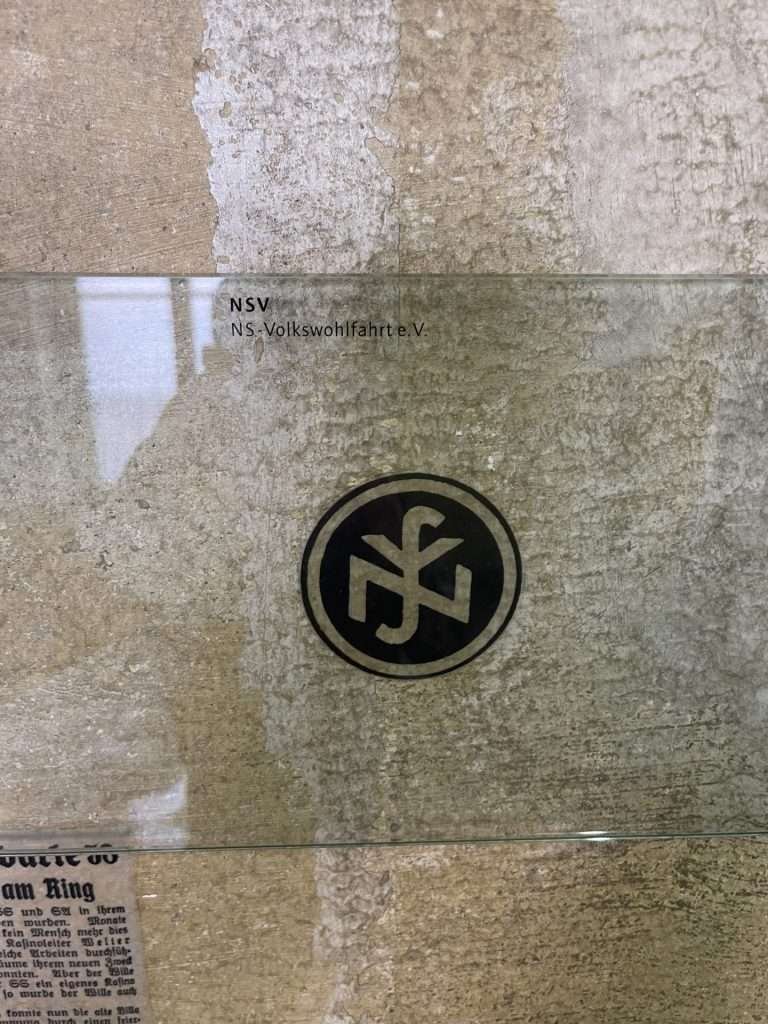
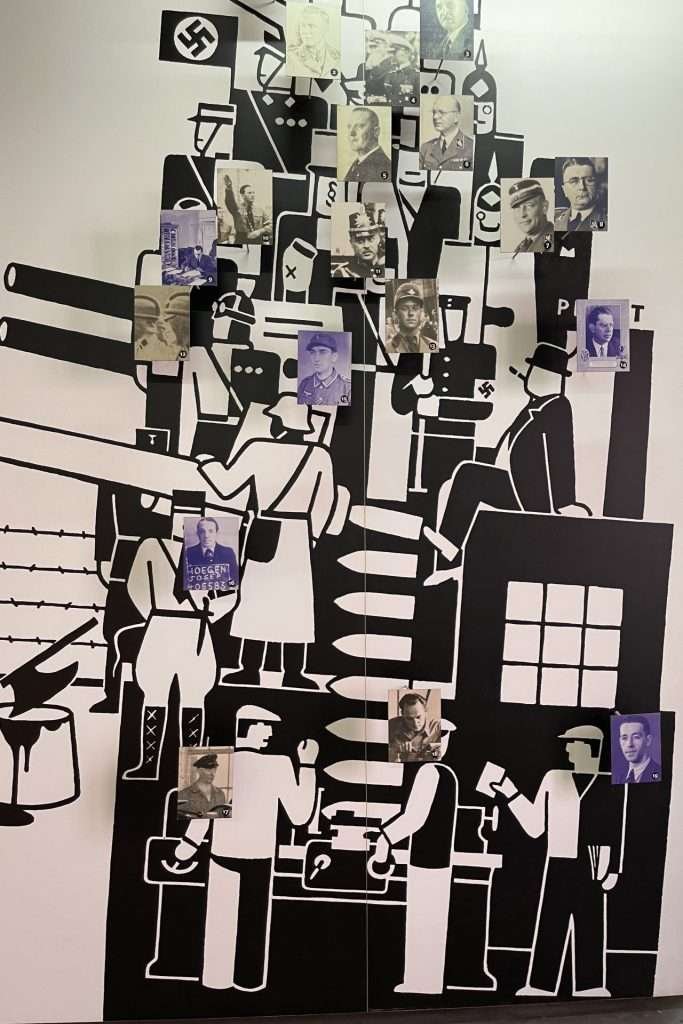
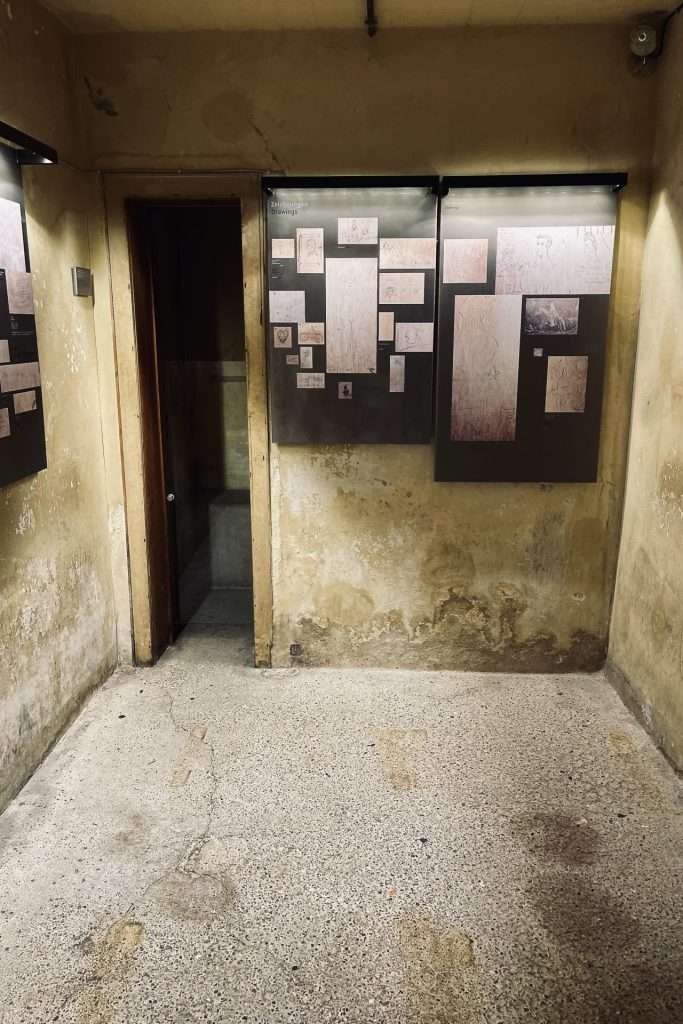

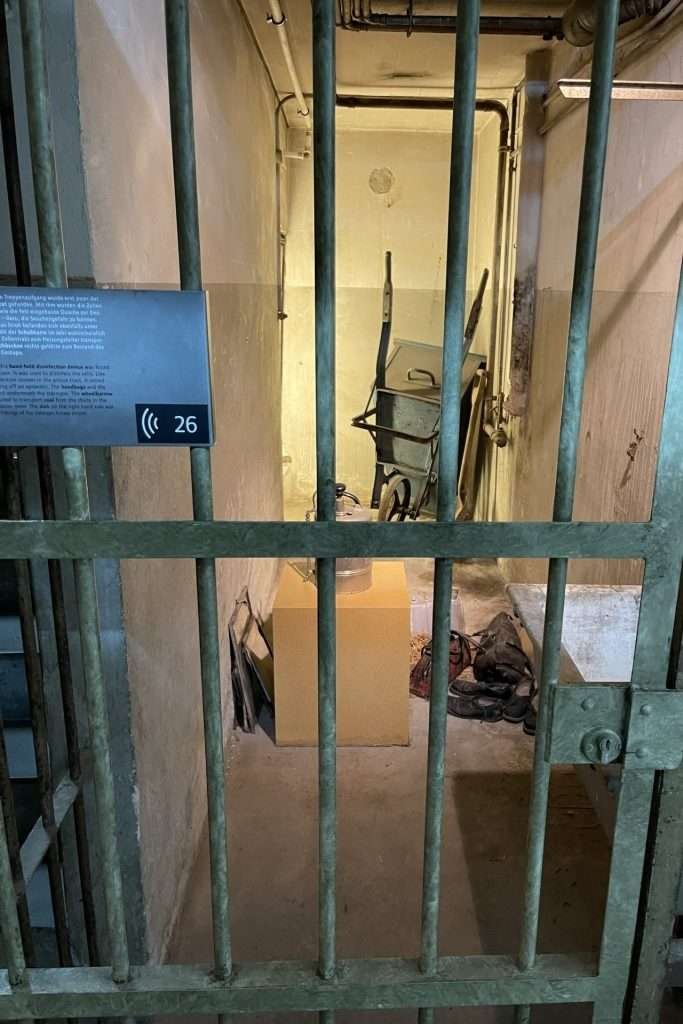
Blackfoot Beach | Köln Germany
Blackfoot Beach is about 15 minutes by car from the Kölner Dom. It’s a great spot for lunch and a cold beer. And for a swim.
Blackfoot Beach is a man-made beach on Fühlinger Lake. The water is clear and Fühlinger Lake is stocked with some large fish. It’s a great spot to just sit, get some sun and have some lunch while relaxing for a few hours.
Its visitors are mostly Köln locals and Blackfoot Beach will give you a glimpse into summer life in the otherwise landlocked region.
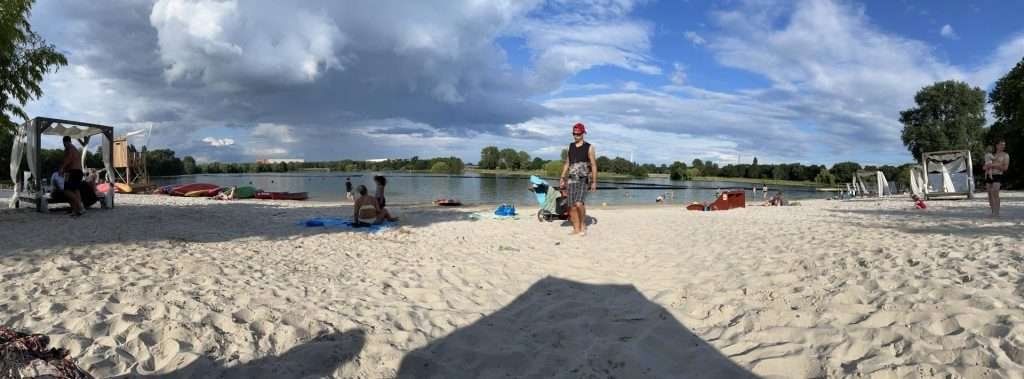
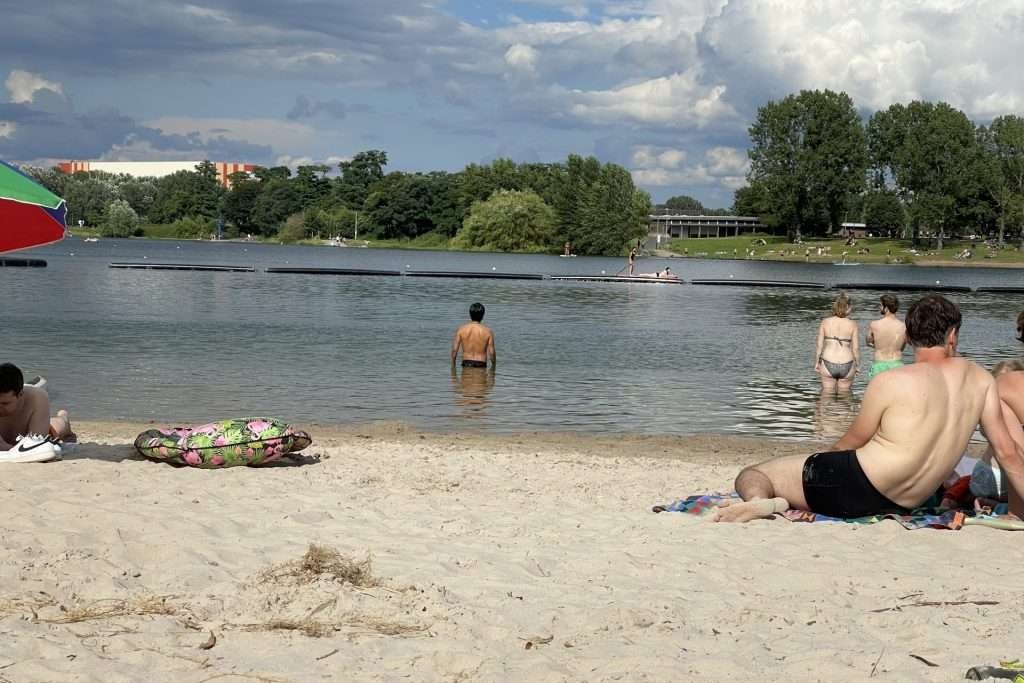
Old Town | Walk Along the Rhine in Köln Germany
Probably my favorite thing to do in any city is to just walk and take in the sights. And Köln lights up so beautifully at night it’s quite relaxing to just walk around the city.
With large pedestrian boardwalks on either side of the Rhine, one of my favorite routes was to cross the Hohenzollern Bridge and walk down one side before crossing the Rhine again via the Deutzer Brücke bridge, wander through the old town and then head back along the boardwalk on the cathedral side.
The old town in Köln isn’t much by European or even German standards. It has a few blocks of old houses and cobblestone alleys but its more of a quick wander than a day spent exploring. Walk through it so you can say you’ve seen it but don’t waste too much time in the old town.
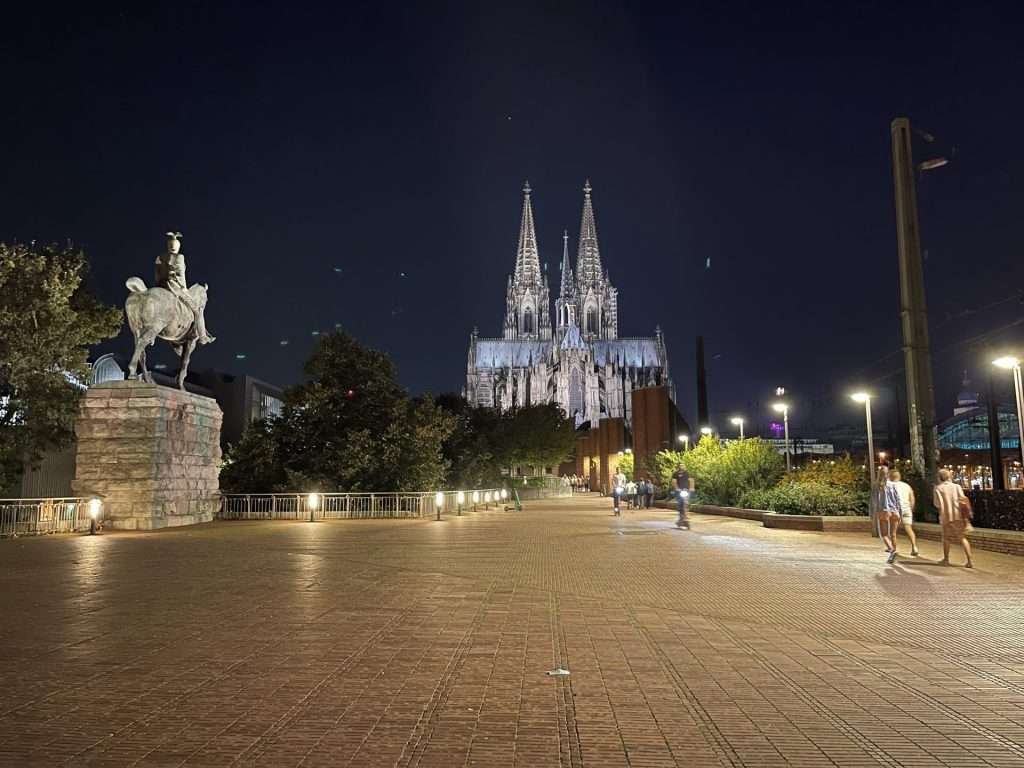


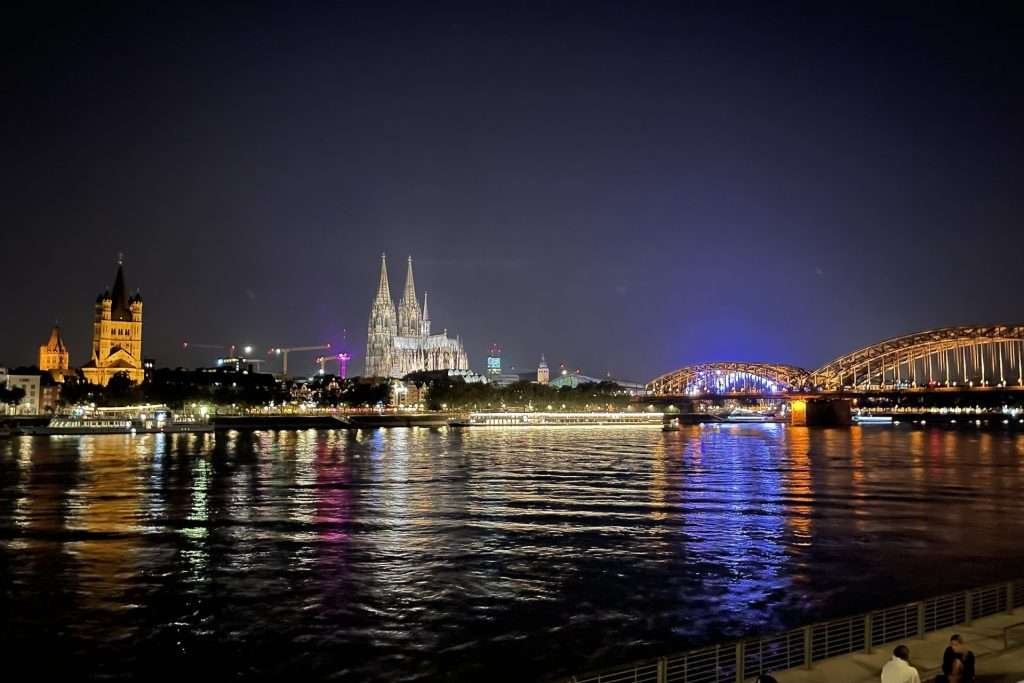


Köln Germany | Conclusions
There’s a heck of a lot of places to see and museums to visit in Köln. But if you see those places I’ve listed in this article you’ll be well on your way to understanding this charming city. And when exploring you should endeavor to try the Kölsch and visit a traditional ‘Brauhaus’.
I’d recommend Brauhaus FRÜH am Dom. And I’d add that if you haven’t experienced a ‘Brauhaus’ in Köln your experience of the city is sorely lacking. I found it amusing to just sit in one of these olden style pubs and watch the tourists.
The tourists would finish their drink, look away, look back and their drink was full again. Because they didn’t know to put a coaster over the top to signal to the waiters that they didn’t want a refill.
If you do have time and your trip coincides with the markets operating in Neumarkt square they’re some of the best in the region. They run Christmas stalls during Christmas. And during the year there is a flea market type setting selling handicrafts and antiques which pops up periodically. The stalls at Neumarkt have a weird and wonderful variety of goods.
Just be sure to visit one of those Brauhaus before hitting the flea markets. It makes them all the more fun.
Liked this article? Share it! Subscribe to the blog, bookmark me and check my other travel articles on Europe. If you’re interested in Germany, see my articles on Berlin, Bonn, Hamburg and other destinations in Germany.



